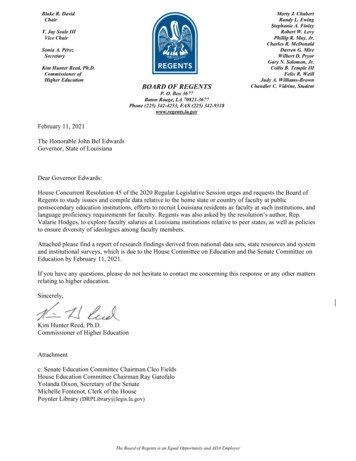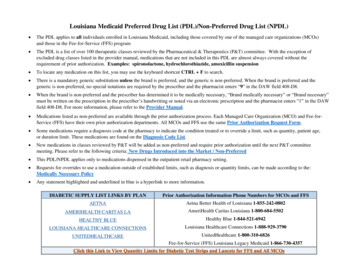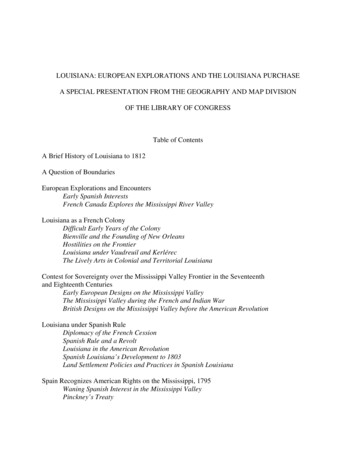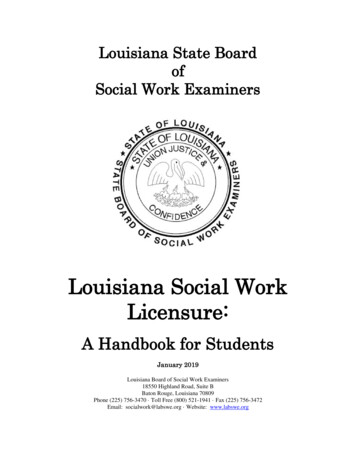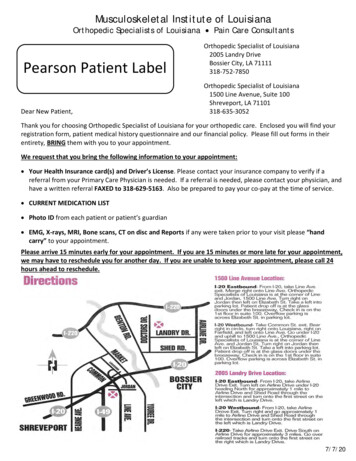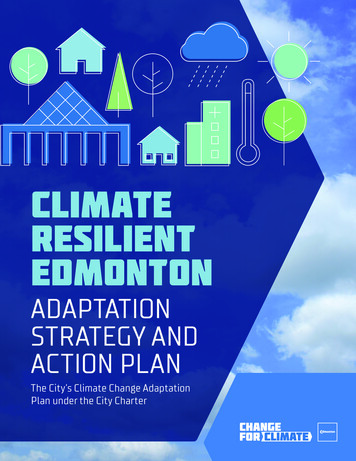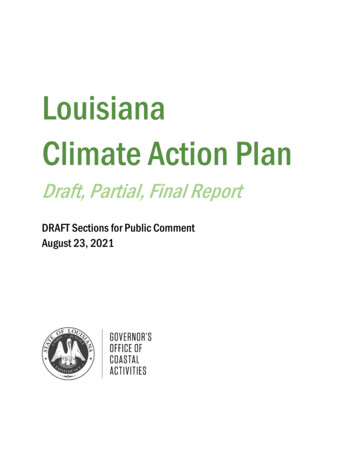
Transcription
LouisianaClimate Action PlanDraft, Partial, Final ReportDRAFT Sections for Public CommentAugust 23, 2021
ContentsClimate Initiatives Task Force (CITF) Membership List . 2Glossary of Terms and Acronyms . 4Executive Summary . 8Introduction . 9Objectives and Targets .10BACKGROUND & EXECUTIVE ORDER . 10GHG EMISSIONS REDUCTION GOALS . 10VISION. 11Planning Process .12STRUCTURED DECISION MAKING . 13Synthesized Fundamental Objectives .16REDUCING NET GHG EMISSIONS . 16CREATING A MORE EQUITABLE SOCIETY. 16STRENGTHENING THE ECONOMY AND WORKFORCE . 16CONSERVING NATURAL RESOURCES & PROTECTING THE ENVIRONMENT . 16ADAPTING TO A CHANGING CLIMATE . 17The Need for Action: Climate Risks to Louisiana.18SCIENTIFIC UNDERPINNINGS . 19HUMAN AND ENVIRONMENTAL IMPACTS TO LOUISIANA. 21HEALTH IMPACTS . 21IMPACTS TO INDIGENOUS PEOPLES . 24ENVIRONMENTAL IMPACTS . 25ECONOMIC IMPACTS TO LOUISIANA . 26ECONOMIC OPPORTUNITIES . 28HEALTH BENEFITS . 29ADVANCING CLIMATE EQUITY . 29Climate Portfolio (strategies and actions) .31Consequence Analysis .32GHG EMISSIONS REDUCTION POTENTIAL ANALYSIS . 32CO-BENEFITS ANALYSIS . 32Gaps and Additional Research Needs .33Implementation Matrix .34Appendix A. Committee and Advisory Group Membership and Charge .35Appendix B. Schedule of Meetings .361
Climate Initiatives Task Force (CITF) Membership List Chip Kline, Executive Assistant to the Governor for Coastal Activities, Task Force Chairo Designee: Harry Vorhoff, Deputy Director, Governor’s Office of Coastal Activities Gregory M. Bowser, President and CEO, Louisiana Chemical Association Jonathan Bourg, Director of Resource Planning and Market Operations at Entergy, as arepresentative of an electric utility Dr. Chuck Brown, Secretary, Louisiana Department of Environmental Qualityo Designee: Lourdes Iturralde, Assistant Secretary, Office of EnvironmentalCompliance Dr. Virginia Burkett, Chief Scientist for Climate and Land Use Change at the United StatesGeological Survey, as a nonvoting representative of a federal scientific agency Selby Bush, BHP Petroleum, designee for the Louisiana Speaker of the House ClaySchexnayder Dr. Terrence Chambers, Director of the Energy Efficiency and Sustainable Energy Center atthe University of Louisiana at Lafayette, as a member of Louisiana’s academic community Flozell Daniels, President and CEO of the Foundation for Louisiana, as a member withexperience in community development and engagement Jay Dardenne, Commissioner of Administration, Division of Administrationo Designee: Mark Moses, Assistant Commissioner, Facility Planning & Control Karen Gautreaux, Director of Government Relations for Louisiana at the NatureConservancy, as a member of the environmental nonprofit community Tyler Gray, President and General Counsel, Louisiana Mid-Continent Oil and Gas Association Bren Haase, Executive Director, Coastal Protection and Restoration Authority Timothy Hardy, Breazeale, Sachse & Wilson, L.L.P., designee for Louisiana Senate PresidentPage Cortez Thomas Harris, Secretary, Louisiana Department of Natural Resourceso Designee: Jason Lanclos, Director, State Energy Office Camille Manning-Broome, President and CEO of the Center for Planning Excellence, as amember at-large Chief Shirell Parfait-Dardar, Tribal Chief of the Grand Caillou/Dulac Band of the BiloxiChitimacha-Choctaw, as a member of an indigenous tribe, nation, or community Colette Pichon Battle, Executive Director of the Gulf Coast Center for Law and Policy, as amember of the environmental and climate justice community Don Pierson, Secretary, Louisiana Economic Developmento Designee: Brad Lambert, Deputy Secretary, Louisiana Economic Development2
Bill Robertson, designee of Public Service Commissioner Foster Campbell Jeff Schwartz, Director of Economic Development for the City of New Orleans, as arepresentative of local government perspective Mike Strain, Commissioner, Louisiana Department of Agriculture and Forestryo Designee: Joey Breaux, Assistant Commissioner, Office of Soil and WaterConservation Dr. Shawn Wilson, Secretary, Department of Transportation and Developmento Designee: Dr. Eric Kalivoda, Deputy Secretary, Department of Transportation andDevelopment Robert Verchick, Gauthier-St. Martin Eminent Scholar and Chair in Environmental Law atLoyola University New Orleans, as a member with special qualifications and experience inclimate change policy3
Glossary of Terms and AcronymsAction: a specific policy, program, or project that can be directly implemented to achieve a specific goal orcomplete a processAdaptation: Long-term adjustments that can be made to aid in withstanding current and future changes inenvironmental conditionsAdaptive Governance Initiative: State-led effort to increase the resilience of state agencies to the impacts ofthe coastal crisis. Working through resilience coordinators at each agency, the adaptive governance initiativeseeks to integrate projections from the coastal master plan into decision making and develop and institutionalizeresilience actions within and across state governmentBlue Carbon: Carbon stored in the sediment and plants of coastal and marine ecosystems, such as mangroves,tidal marshes, and seagrass bedsBlue Hydrogen: Hydrogen is a fuel source that has multiple applications in transportation, electricity generation,industrial uses, and many more. Blue hydrogen is produced through the typical reforming process used to createmost of the hydrogen used today, but the carbon dioxide that is emitted from that process is captured and storedrather than being released into the atmosphereCarbon Capture: The process of pulling carbon dioxide from the atmosphere naturally or through engineeredmethods from a point source emitterCarbon Sequestration: The long-term capture and storage of carbon in oceans, soils, vegetation, and geologicformations, which can occur either naturally or through anthropogenic (human) mechanismsCarbon Sink: Any reservoir, natural or otherwise, that accumulates and stores some carbon-containing chemicalcompound for an indefinite period and thereby lowers the concentration of CO₂ from the atmosphere by storingmore carbon than it emitsCarbon Storage: The containment of captured carbon when it is injected into deep, underground geologicalformations, where it is stored long-term, rather than being released into the atmosphere. Storage sites used forCO₂ include former oil and gas reservoirs, deep saline formations, and coal bedsCarbon Dioxide (CO 2 ) Equivalent: The number of metric tons of CO 2 emissions with the same global warmingpotential as one metric ton of another greenhouse gas (GHG)Climate Equity: a people-centered approach to addressing the global climate crisis through action that seeks toachieve long-term equality of outcomes by acknowledging institutionalized harms to historically marginalizedpeople and communities and by holding accountable those who benefit from the root causes of climate changethat disproportionately impact the most vulnerable4
Coastal Protection and Restoration Authority Board (CPRA Board): Group that represents the state’sposition in policy relative to the protection, conservation, enhancement, and restoration of the coastal area of thestate. They do so by overseeing the Coastal Protection and Restoration Trust Fund, developing a master plan anannual plan for integrated coastal protection, and enforcing compliance with the Coastal Master PlanCoastal Master Plan: The state’s 50-year blueprint for large-scale restoration and protection of Louisiana’scritical coastal areas. The plan, authored by the Louisiana Coastal Protection and Restoration Authority (CPRA),is updated every five years as required by law to account for evolving science and changing environmentalconditions. It combines projects that restore, build or maintain coastal wetlands with projects that provideenhanced risk reduction for coastal communities from storms and floodingEquity: Fairness or justice in the way people are treated, recognizing that we do not all start from the same placeand must acknowledge and make adjustments to imbalances. This can be achieved by expanding access toopportunity, quality of life and prosperityEmissions Pathway: The modelled trajectories of global anthropogenic emissions over the 21st century basedon predictions of how concentrations of GHG in the atmosphere will change in the future as a result of humanactivitiesFundamental Objectives: In Structured Decision Making (SDM), these are essential goals or solutions of thiswork that have been informed by the Climate Initiatives Task Force, Advisory Groups, Sector Committees, andpublic that guide development and evaluation of strategies and actionsGreen Hydrogen: Hydrogen is a fuel source that has multiple applications in transportation, electricitygeneration, industrial uses, and many more. Green hydrogen is produced using renewable energy throughelectrolysis. This is a process that splits water into its basic elements – hydrogen and oxygen – using an electriccurrent. The electricity used in the process comes from renewable resourcesGreenhouse Gas (GHG): A gas that contributes traps heat in the atmosphere by absorbing infrared radiation.The primary GHG in Earth's atmosphere are water vapor, CO 2 , methane, nitrous oxide, and ozone. Many GHGs arenaturally occurring, though concentrations can be affected based on human inputGHG Inventory: A list of emission sources, sinks, and the associated emissions over a certain period of time,quantified using standardized methodsIntergovernmental Panel on Climate Change (IPCC): An intergovernmental body of the United Nations that isdedicated to providing the world with objective, scientific information relevant to understanding the scientificbasis of the risk of human-induced climate change, its natural, political, and economic impacts and risks, andpossible response optionsLouisiana Watershed Initiative: State-led program through which floodplain management responsibilities arecoordinated across federal, state, and local agencies, with the goal being to leverage the state’s past andpresent flood-risk reduction and resilience efforts through a variety of projects5
Mitigation: Generally, The reduction of something harmful or the reduction of the severity, seriousness, orpainfulness of its harmful effects. In the climate context, mitigation refers to efforts to avoid and reduce theemission of GHGNational Academy of Sciences: A United States nonprofit, non-governmental organization charged withproviding independent, objective advice to the nation on matters related to science and technology. Theorganization is committed to furthering science in America, and its members are active contributors to theinternational scientific communityNational Climate Assessment: Summary reports detailing the impacts of climate change on the U.S. now and inthe future. They are updated and released approximately every 5 years, starting in 2000, through the GlobalChange Research Act of 1990. The reports are extensively reviewed by the public and experts, including federalagencies and a panel of the National Academy of SciencesOffice of the Governor—Coastal Activities (GOCA): Team within the Governor’s Office that develops andimplements policies, plans, and programs relative to the protection and restoration of Louisiana's unique coastalresources and the flood protection of communities in the state, as well as climate and coastal resiliencyPlanning Team: Consists of staff from the Office of the Governor—Coastal Activities and the Water Institute ofthe Gulf (TWI) tasked with coordinating the planning process for the development of the Climate Action Plan andits timely completionPortfolio: A comprehensive set of strategies and actions towards achieving the GHG reduction targets and otherfundamental objectivesRelative Sea Level Rise: A combination of the absolute (global) sea level rise, which is the change in the heightof the ocean surface above the center of the earth, plus changes (up or down) in land elevation for the relevantcoastal area. Sea level rise at specific locations may be more or less than the global average due to many localfactors such as subsidence, ocean currents, variations in land height, and whether the land is still reboundingfrom the compressive weight of Ice Age glaciersResilient Louisiana Commission: State entity charged with examining Louisiana’s economy amid the COVID-19pandemic and making recommendations for more resilient business-related activities and commerce thatincludes a task force structure dedicated to strengthening specific sectors of Louisiana’s economy. The RLC wasspecifically created to guide the state through the Covid-19 crisis and expand the economy so that it can copemore easily with any future crisesWater Institute of the Gulf: An independent, non-profit, applied research institution advancing science anddeveloping integrated methods to solve complex environmental and societal challenges. The Water Institute is apart of the Water Campus and works to develop scientific and technological solutions to coastal and deltaicissues in Louisiana and the Gulf in general. The Institute connects academic, public, and private researchproviders and conducts applied research to serve communities and industry and that will help coastal6
communities and economies become more resilient to land subsidence, storms, rising sea levels, and othercoastal threatsStrategy: A high-level path (plan of action or policy) designed to achieve a major or overall aim/ one or morelong-term or overall goals under conditions of uncertainty (e.g., GHG emissions reduction)Structured Decision Making (SDM): An explicit and transparent approach that utilizes a broad set of methodsfor analyzing decisions and identifying solutions that achieve desired outcomes. This approach supportsdecisions based on clearly articulated fundamental objectives, integrates science and policy, and remainsflexible to legal mandates and public preferences (or values) in decision makingVector-Borne Disease: Human illnesses caused by parasites, viruses and bacteria that are transmitted byvectors, which are living organisms that can transmit infectious pathogens between humans, or from animals tohumans7
Executive SummaryAn executive summary will be included in the final report.8
IntroductionIn August of 2020, Governor John Bel Edwards signed executive order JBE 2020-18, formally creatingthe Climate Initiatives Task Force (CITF) to make recommendations for how Louisiana could play itspart in reducing the greenhouse gas (GHG) emissions driving up global temperatures and changingthe world’s climate, a crisis with direct and immediate impacts for Louisiana’s people and future. Aftermultiple public meetings of the CITF and across supporting groups of experts, this Louisiana ClimateAction Plan [will be] formally adopted in January of 2022.This plan provides an overview of the Governor’s vision for climate action in Louisiana, establishes theurgent need for action based on the global and local threats posed by increasingly severe impacts ofclimate change, and discusses opportunities for Louisiana presented by considered climate action. Itexplains the planning process and utilized to arrive at this strategy, provide an update to Louisiana’sGHG sources and sinks inventory, and lay out the strategies and actions recommended for economywide reductions to GHG emissions alongside projections for how implementing this plan will reduceGHG emissions and provide co-benefits to our state.There is no single solution that will fix the world’s climate problems overnight, and many damagingchanges to the environment with harmful human consequences are already being felt and will be feltin Louisiana no matter the success of this Climate Action Plan. However, choosing to act in the face ofthese difficult truths is still essential work.Not taking action is a choice to pass even more harmful impacts resulting from climate change downto the next generation and makes the task of adapting to life on the edge of the Gulf of Mexico evenmore difficult and costly. Choosing inaction ignores the long-standing inequities present in our statethat contribute to the disparate climate impacts felt across our communities and turns a blind eye tothe new injustices created and magnified by a rapidly changing climate. Inaction is also the surest wayto miss opportunities. By taking action to address GHG emissions in Louisiana, our state has anopportunity to improve the health and enhance the quality of life for our people and to create a morevibrant, inclusive economy. Ultimately, it is a chance to ensure that this state remains one that we, ourchildren, and children’s children want and can invest in.The dedicated members of the CITF, its sector committees, and advisory groups worked relentlesslyover 16 months to choose action over inaction. This diverse group of leaders came together to havehard conversations, set priorities, discuss tradeoffs, and produce this Louisiana Climate Action Planwhich establishes a pathway to reach the state’s emission reduction goals and a to a healthier, safer,more equitable, and vibrant state. While this plan is an important first step toward decarbonization,the road to 2050 will include many new developments and inevitable setbacks, and the strategies andactions laid out here will need to be revisited for their ambition, effectiveness, and continued relevancein the years to come. But the first, crucial order of business will be the effective implementation of thisplan, a task that will depend on the continued collaboration, public engagement, and commitment thatproduced this plan and much more.9
Objectives and TargetsBACKGROUND & EXECUTIVE ORDERShortly after his inauguration in February of 2020, Governor Edwards held a press conference toannounce his second term policy priorities for the coastal program. Attended by nearly every memberof his cabinet, Governor Edwards committed to forming the CITF that would develop a set ofrecommendations to address the state’s GHG emissions. This effort was formalized at the August2020 Coastal Protection and Restoration Authority (CPRA) Board meeting when he signed ExecutiveOrder JBE 2020-18.Referencing the value of Louisiana’s coast and the projections for an additional 2,250 to 4,120 squaremiles of coastal land loss over the next fifty years, Executive Order JBE 2020-18 connects Louisiana’scoastal crisis, the catastrophic human costs of natural disasters, and the international scientificconsensus that GHG emissions are causing unprecedented global warming. “To improve ourresilience, sustain our coast, and help avoid the worst impacts of climate change,” the order states,“Louisiana must proactively work to reduce the GHG emissions that are driving up global temperatures,raising sea levels, and increasing risks that threaten our health and safety, quality of life, economicgrowth, and vital habitats and ecosystems.” Governor Edwards also clearly articulated his desire forsolutions to this problem to be developed in partnership with multiple stakeholders with the ultimategoal of reaching a “balanced” set of strategies that would both help “limit the impacts of climatechange that harm our state’s natural and cultural heritage,” and provide ways for us to adapt “tomaintain [our] position as a world leader in energy, industry, agriculture, and transportation.”The Executive Order established a twenty-three-member CITF, supported by six sector committees andfour advisory groups, and called for an updated GHG emissions inventory, an interim report in Februaryof 2021, and a final climate strategy by February of 2022.GHG EMISSIONS REDUCTION GOALSImportantly, the Executive Order also established ambitious GHG reduction goals to focus the work ofthe CITF on the best approaches to meet these goals. According to the Executive Order, by 2025,Louisiana should: 1) reduce its net GHG emissions by 26-28% from 2005 levels; 2) reduce its net GHGemissions by 40-50% from 2005 levels by 2030; and 3) aim to be a net zero GHG emitter by 2050.These goals are derived in part from the declaration by the Intergovernmental Panel on Climate Change(IPCC) that “global net human-caused emissions of carbon dioxide.would need to fall by about 45percent from 2010 levels by 2030, reaching ‘net zero’ around 2050.” 1 It also aligns with the U.S.’Nationally Determined Contributions (NDCs) which represent its commitment in the Paris Agreementto limit global warming to 1.5 C, 2 and are calibrated to 2005 to correspond to Louisiana‘s 2010 GHGinventory which was built on data from 2005. Additionally, Governor Edwards’ goals put Louisiana inline with commitments made by dozens of other states, and businesses operating in multiple sectorsinternationally, nationally, and within Louisiana. These businesses are from a variety of industrial10
sectors including energy producers, public utilities, chemical manufacturers, technology firms, andfinance.VISIONGovernor Edwards’ Executive Order also clearly established a vision for Louisiana, one that addressesclimate change head on while being open to opportunities that stretch our traditional economicstrengths to remain competitive in a global, low-carbon economy. Our state “can and will reduce GHGemissions to limit the impacts of climate change that harm the state’s natural and cultural heritagewhile adapting to maintain its position as a world leader in energy, industry, agriculture, andtransportation.”The realization of that vision has been the central mission of the CITF. With input from the public andexperts, it has investigated and offered recommended actions including in this plan for the reductionof GHG emissions in Louisiana to achieve the stated GHG emissions reduction goals. In addition toGHG reductions, the CITF also considered other important outcomes in the formulation of this planincluding: improving the health and welfare of the people of Louisiana, becoming a more equitablesociety, strengthening our ability to adapt to environmental hazards, and advancing Louisiana’seconomic and energy profile. Notably, the CITF exists alongside and builds upon other state effortssuch as the Louisiana Watershed Initiative, the Coastal Master Plan, the Adaptive GovernanceInitiative, and the Resilient Louisiana Commission.11
Planning ProcessGovernor Edwards called on the CITF to produce a Climate Action Plan that outlines actions to reducenet GHG emissions from all sectors of the economy and to set Louisiana on a path to meet its short-,medium-, and long-term emission reduction goals. Actions and strategies reduce GHG emissions whileachieving other co-benefits for Louisiana's communities, environment, and economy. Achieving thisvision and the state’s emission reduction goals in a manner that is inclusive and balanced required adeliberate and transparent planning process.STRUCTUREThe CITF, its sector committees, and advisory groups comprise over 140 experts from stategovernment, colleges and universities, the private sector, and civil society that have advised andcontributed to the portfolio of strategies and actions contained in this Climate Action Plan (see Figure1).Figure 1. Climate Initiatives Organizational StructureThe CITF is the decision-making body tasked with submitting an interim report and Climate Action Planto Governor Edwards in accordance with the executive order. This twenty-three-member body setpriorities for the overall planning process, weighed trade-offs among different approaches, andultimately approved a set of recommendations for the Climate Action Plan.12
The four advisory groups were charged with providing technical expertise to the CITF and committeesthroughout the process and upon request regarding questions that transcend individual committeescopes. While each of the four advisory areas are reflected in the membership of the CITF and sectorcommittees, specific opportunities to evaluate and improve actions and strategies are necessary toensure the planning process accounts for equitable impacts, sound science, financial feasibility andeconomic implications, and legal considerations in each step. In addition to discussions duringmeetings, advisory groups provided key feedback during two rounds of consequence analysis. At eachround, advisory group members expressed how groups of actions to reduce GHG emissions couldresult in positive or negative impacts on the social, economic, and resilience outcomes of the plan.More information about the membership and charges of the equity, financial, legal, and scientificadvisory groups can be found later in this document.GHG emission sources and sinks are present in all aspects of the Louisiana economy. To acknowledgethe progress already being made and discuss the specific opportunities to reduce emissions from abroad range of operations and activities in each sector, six sector committees were charged withdeveloping and evaluating implementable emission reduction actions and comprehensive strategiesthat significantly reduce net GHG emissions across all aspects of their respective sector. Committeesare reflective of the Governor’s vision to achieve balance through their broad-based composition withrepresentatives from corporate entities, advocacy organizations, regulators, academics, andcommunity representatives. Bringing together a variety of stakeholders with seemingly separateinterests and opposing values allowed for robust and challenging discussions that ensure the endresult of comprehensive strategies that set Louisiana on a path to reach short-, medium-, and longterm GHG emission reduction goals.The CITF is chaired and staffed by the Office of the Governor, Coastal Activities (GOCA). Underleadership of the Executive Assistant to the Governor for Coastal Activities, GOCA serves as the staffand managers of the CITF, advisory groups, and sector committees in coordination with advisory andcommittee chairs. As staff of this effort, GOCA also works alongside all members, state agencies,outside stakeholders, and the public to build investment in the process, expand partnerships, andcoordinate among all entities. As Louisiana’s Innovation and Collaboration Hub, the Water Institute ofthe Gulf (TWI), assists GOCA as it led the planning process for and development of the Climate ActionPlan. This Planning Team, comprised of GOCA and TWI, ensures the CITF remains on track to meetdeliverables within their respective timelines.STRUCTURED DECISION MAKINGThe planning process for developing the Climate Action Plan is grounded in a Structured DecisionMaking (SDM) approach. In basic terms, SDM is “a formalization of common sense for decisionproblems which are too complex for informal use of common sense”. 3,4 SDM is an approach thatintegrates science and policy to break down complex decisions and identify solutions that achieve thedesired ends (referred to as “fundamental objectives” in SDM) in a manner that is explicit andtransparent. SDM is not a prescriptive approach to problem solving, but rather it en
state. They do so by overseeing the Coastal Protection and Restoration Trust Fund, developing a master plan an annual plan for integrated coastal protection, and enforcing compliance with the Coastal Master Plan Coastal Master Plan: The state's 50-year blueprint for large-scale restoration and protection of Louisiana's critical coastal areas.

